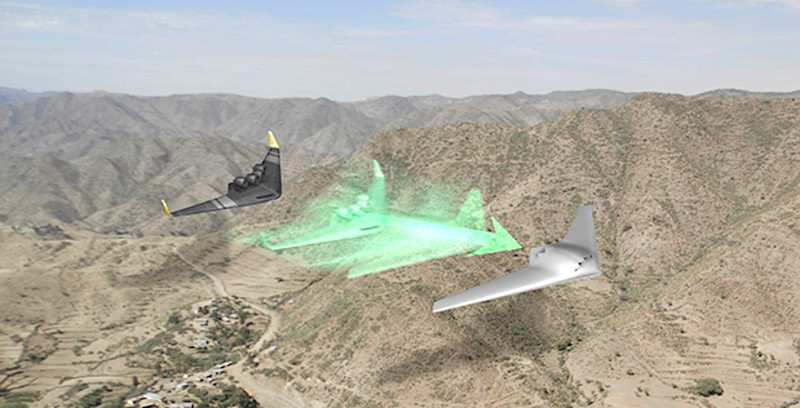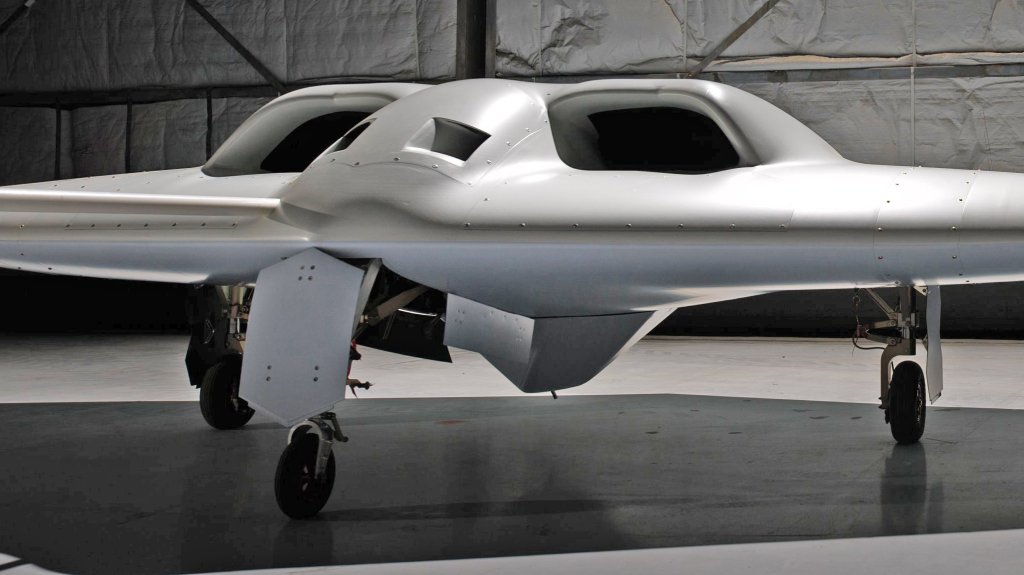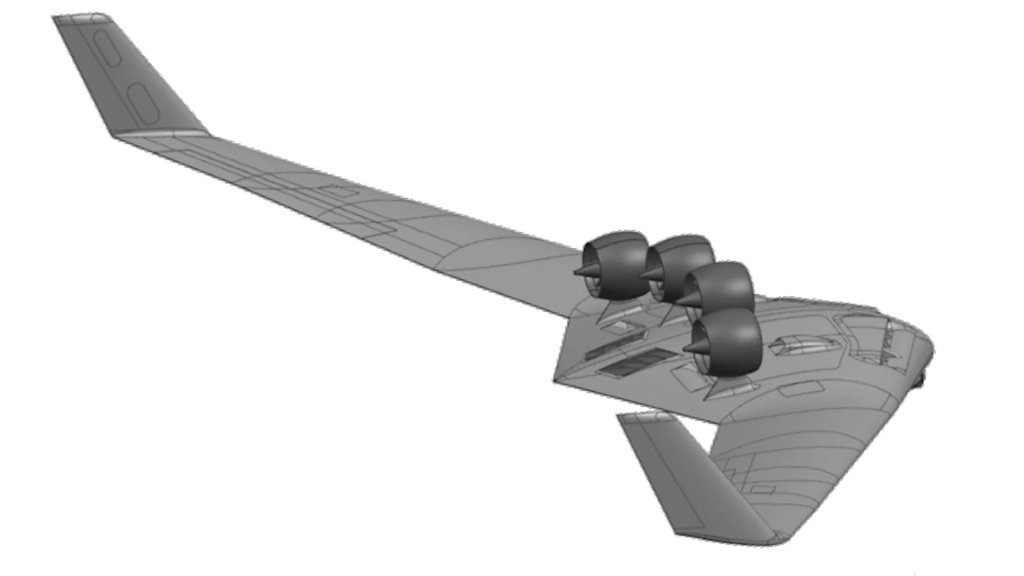Northrop Grumman has provided the first definitive photo of its Series Hybrid Electric Propulsion AiRcraft Demonstration (SHEPARD) drone, also known as XRQ-73. The image gives us a much better look at the flying wing vehicle, which is built in collaboration with the company’s subsidiary Scaled Composites and DARPA, and features a breakthrough, highly efficient, and whisper-quiet hybrid-electric propulsion system.
When the first image of the XRQ-73 was released, it was unclear if this was a rendering of the design or an actual photo overlaid on a computer-generated background, although we thought the latter was the case. The new photo confirms this and that the XRQ-73 airframe has been built.


The XRQ-73 has a tailless flying wing planform, broadly similar to the Lockheed Martin Skunk Work’s RQ-170 Sentinel, P-175 Polecat, and X-44A. You can read our basic analysis of the planform of the aircraft in our past report here.

Very prominent are the two relatively enormous air intakes on top of the central section of the fuselage. These inlets are located on either side of a central fairing, which itself has two rectangular apertures at the front which appear to be another set of intakes. It’s not clear what these are for, but cooling for the hybrid powerplant and the aircraft’s electronics is the top possibility. It could also provide additional clean airflow to the powerplant during takeoff and landing operations.
Meanwhile, in the preceding XRQ-72A, two multi-sectioned inlets at the front of the fuselage fed air to two fuel-powered generators, which in turn provided electric power to four ducted fan propulsors mounted on top of the rear of the central fuselage. Those propulsors are not embedded in the fuselage itself, with a DARPA official previously mentioning they planned to “wrap” the concept in a more survivable, operationally relevant airframe.

Another interesting feature of the XRQ-73 that was not visible in the previous rendering is a large, faceted fairing below the central section of the fuselage. This is very likely a sensor enclosure that can handle different kinds of electro-optical, radar, and passive radio-frequency payloads. This general arrangement also exists on the similarly-shaped RQ-170 Sentinel.
While the photo released today shows the XRQ-73 parked in a hangar, its landing gear is partly obscured. Nevertheless, this is of the tricycle type with single wheels on the main units and a notably large three-piece door for the nose unit.

Also new is the air data probe offset on the nose of the drone, a feature found on most aircraft during their test-flight phases. DARPA has said it hopes to flight test the XRQ-73 later this year, which would also correspond with the program’s overarching ambition to leverage “hybrid electric architecture and component technologies to quickly mature a new mission-focused aircraft design,” as Northrop Grumman states. The aim is to demonstrate that the XRQ-73 can be operationalized relatively quickly to meet an unspecified “urgent operational need.”
Based on the RQ-series designation, it’s safe to assume that the drone is primarily intended for intelligence, surveillance, and reconnaissance (ISR), although other missions shouldn’t be ruled out. A stealthy and very quiet drone of this kind would appear to be ideal for covert surveillance in denied areas, as well as missions requiring persistence at extended ranges. Somewhere below the RQ-170 and above smaller, catapult-launched designs such as the Northrop Grumman’s Bat, is where such a system would most likely fit in the overall unmanned aerial system hierarchy.

Being able to survive and persist in semi-contested areas, where MQ-9 Reaper drones have become increasingly vulnerable, as well as support special operations and clandestine intelligence-driven operations, would be a likely fit for this drone. Being extremely quiet and comparatively cool in terms of infrared signature, along with reduced detection to radar systems, would be highly beneficial for such applications, especially for monitoring patterns of life over long periods of time without being noticed.
While the aircraft has clear low-observable features that were drivers in its airframe design, it is unlikely to be classified as a very-low observable platform, at least to radar. Infrared and acoustic signatures could be extremely small for its performance class due to the hybrid propulsion system, but its ability to evade radar appears to be balanced against a mid-tier threat environment, component sensitivity, and cost.
When it comes to size, we addressed this in our prior report:
“No details about the XRQ-73’s expected performance appear to have been released so far, but DARPA says it is a Group 3 uncrewed aerial system (UAS) weighing approximately 1,250 pounds, which will include “operationally representative … mission systems.” By the U.S. military’s definitions, a Group 3 UAS weighs between 55 and 1,320, can fly at altitudes between 3,500 and 18,000 feet, and has a top speed of between 100 and 250 knots.
At 1,250 pounds, the XRQ-73 is set to be substantially larger than the XRQ-72A, the requirements for which called for a drone weighing between 300 and 400 pounds. The XRQ-72A also had a 30-foot wingspan, a length of 11.2 feet measured from the nose to the ends of the wingtips, and a height of four feet when including the vertical wingtip stabilizers, according to schematics The War Zone previously obtained via the FFreedom of Information Act.
We do know that the design is heavily informed by experience with the Great Horned Owl (GHO) program, which produced the XRQ-72A. In particular, the hybrid electric architecture and “some of the component technologies” have been lifted from the earlier program, which ran from the early 2000s until sometime in the 2010s and which you can read about in detail here.

For its part, the SHEPARD program has been running since 2021, led by DARPA in cooperation with the Air Force Research Laboratory (AFRL) and the Office of Naval Research (ONR). SHEPARD evolved from an earlier and broader hybrid-electric propulsion project at DARPA called Air-Ground Autonomous VEhicles (AGAVE).
Taken as a whole, the XRQ-73 is a fascinating program. Thanks to its propulsion system combined with low-observable features, it is also one that could significantly impact America’s intelligence-gathering capabilities, especially if these drones can be procured in higher numbers than the heavier, jet-powered RQ-170.
For now, the program still holds many secrets, but with a first flight expected before the end of the year, we are very likely to learn more before too long.
Contact the author: thomas@thewarzone.com and tyler@twz.com
